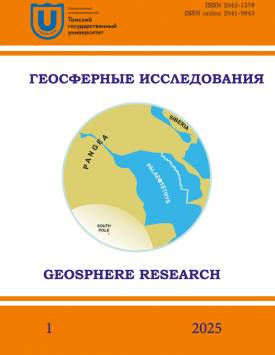Taxonomic composition of calcareous algae and microfacies of the Upper Ordovician formations of the northeastern Gorny Altai
The territory of the Gorny Altai includes a wide range of bedrock formations from the Ordovician period. The composition and origin of these rocks also varies widely, with both terrigenous layers (from argillite to conglomerate) and carbonate beds (limestone, dolomite and transitional forms) being known. For example, reef-forming bodies are exposed in the western and northwestern parts of the Gorny Altai, while normal-laminated limestone is recorded in large numbers in the northeastern part of the Gorny Altai. The Ordovician of the Gorny Altai has been studied for a long time, but there is very little information about calcareous algae in the literature. However, during field work, rock material was collected from several sections of the northeastern Gorny Altai ("Biya", "Lebed’", and "Bura"). Petrographic thin sections were made from this material. Their study showed a high content of calcareous algal remains in these outcrops. The detected remains were identified as Girvanella Nicholson et Etheridge, 1878, Vermiporella Stolley, 1893, Contexta Gnilovskaja, 1972 and Solenopora Dybowsky, 1878. In addition to these calcareous algal remains, invertebrate bioclasts such as trilobites, ostracods, corals, bryozoans, shell brachiopods, gastropods and echinoderm fragments were found in the studied strata. In addition to identifying calcareous algae, carbonate rock structures (as classified by R. Dunham with additions) and carbonate microfacies have been identified. It has been determined that microfacies of polybioclastic wackestones to packstones, algal-peloid packstones, polybioclastic-oolitic packstones to grainstones, trilobite-algal wack-estones to packstones, and recrystallized silty limestones may be present in these sections. Good and average preservation of calcareous algae finds allowed us to perform their brief paleontological description and to establish that some Gorny Altai species are closely related to the apparent remains described in the Ordovician of China, East Kazakhstan, Norway, Scotland and other localities. Thus, the remains of the genus Solenopora were identified as Solenopora aff. spongoides Dybowski, Vermiporella was identified as Vermiporella aff. diffluens Gnilovskaja, and the preserved calcareous covers of Girvanella were identified as Girvanella problematica Nicholson et Etheridge, 1878. Upper Ordovician sedimentation is assumed to have occurred near the source of organogenic remains. However, it is possible that the source of clastic material was located distant from the deposition basin. At the same time, there is evidence that the energy of transport agents may have increased, leading to the formation of clastic packs. A model for the possible formation of these strata is proposed. the authors are grateful to O.T. Obut, R.A. Khabibulina, D.A. Tokarev and T.A. Scherbanenko for advices and assistance in collecting samples in the field, to V.A. Luchinina for paleoalgological consultations and to the reviewer for valuable comments. The authors contributed equally to this article. The authors declare no conflicts of interests.
Keywords
methodology, Gorny Altai, Upper Ordovician, carbonate rocks, calcareous algaeAuthors
| Name | Organization | |
| Zakiryanov Ilya G. | Trofimuk Institute of Petroleum Geology and Geophysics, SB RAS; A.N. Zavaritsky Institute of Geology and Geochemistry, UB RAS | ZakiryanovIG@gmail.com |
| Sennikov Nikolay V. | Trofimuk Institute of Petroleum Geology and Geophysics, SB RAS | SennikovNV@ipgg.sbras.ru |
References

Taxonomic composition of calcareous algae and microfacies of the Upper Ordovician formations of the northeastern Gorny Altai | Geosphere Research. 2025. № 1. DOI: 10.17223/25421379/34/1
